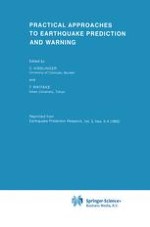1985 | OriginalPaper | Buchkapitel
Space Techniques for Earthquake Studies
verfasst von : David E. Smith
Erschienen in: Practical Approaches to Earthquake Prediction and Warning
Verlag: Springer Netherlands
Enthalten in: Professional Book Archive
Aktivieren Sie unsere intelligente Suche, um passende Fachinhalte oder Patente zu finden.
Wählen Sie Textabschnitte aus um mit Künstlicher Intelligenz passenden Patente zu finden. powered by
Markieren Sie Textabschnitte, um KI-gestützt weitere passende Inhalte zu finden. powered by
During the last decade the techniques of satellite laser ranging and very long baseline interferometry have been developed to the level where the relative motions of points on the earth can be measured to accuracies of a few centimeters. These techniques are being used in many parts of the world to monitor the apparent large scale motions of the major tectonic plates and the stability of these plate interiors. During the next 5 years we can expect the motions of many plates and plate interiors to have been measured to an accuracy of ± 1 cm/yr averaged over about 5 years and that the stability of these motions will be one of the major questions. During the last few years the application of the Global Positioning System (GPS) to geodesy has been a major development area. This technique is now in final stages of testing and is participating in experimental observing programs. The GPS system technology is ideally suited for application to problems of regional surveying and is expected to provide a few centimeter accuracy over baseline distances of several hundred kilometers. The GPS systems are lightweight, need a minimum of support, and remain on site only a few hours to collect sufficient data. These systems, coupled with the very long baseline capability of laser ranging and very long baseline interferometry, will provide the extension of ground based geodesy and global geodetic control to the whole world.
